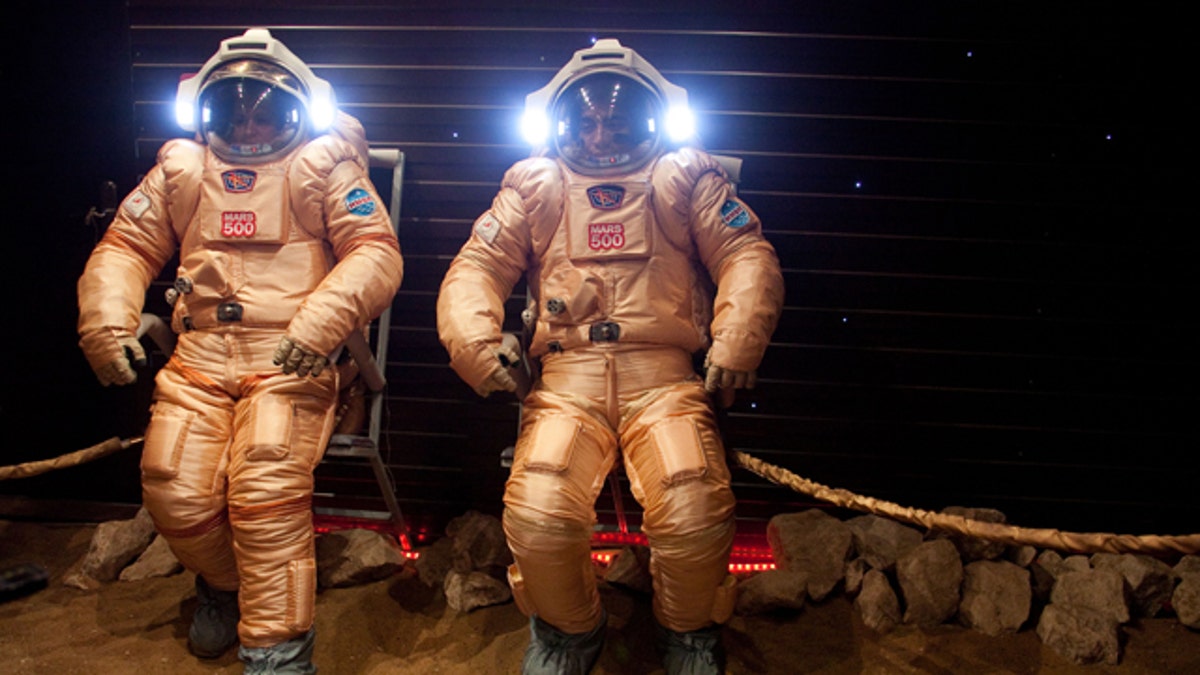
May 24, 2010: Researchers test spacesuits on a simulated Mars surface during a training session at Moscow's Institute for Medical and Biological Problems. (AP Photo/IBMP, Oleg Voloshin)
MOSCOW – An all-male crew of six astronauts -- pale but smiling after 520 days trapped a capsule on the Russian flats -- stumbled back into the light of day Friday morning, following the longest ever simulation of a trip to Mars.
But did these brave astronauts make a sacrifice for the sake of science or were they just taken for an $8-an-hour ride?
Their mission meant being trapped for a year and a half in living compartments the size of a bus, connected with several other similarly sized modules for experiments and exercise. During the experiment, they communicated with their families via the Internet, which was delayed and disrupted to imitate space travel. They ate canned food similar to that offered on the International Space Station.
Scientists said the experiment mimicked the stress and fatigue of interplanetary travel -- minus the weightlessness, of course. And minus the travel. And minus the success, joy, and sense of accomplishment of having actually traveled anywhere, or actually reached Mars.
"The mission is accomplished, the crew is in good health and is ready for new missions," team leader Alexey Sitev reported to Russian space officials. "The crew has completed the experiment."
But at what cost? About $8 per hour.
The organizers said the three Russians, a Frenchman, an Italian-Colombian and a Chinese man will be paid about $100,000 (except the Chinese researcher whose reward hasn't been revealed by Chinese officials).
$100,000 for 520 days works out to $192.31 per day. Since the commitment was full time -- the astronauts were locked up for 24 hours a day, every day, for 520 days -- that fee works out to almost exactly $8 per hour.
Would YOU take a 520-day trip to "Mars" for $8 an hour?
Psychologists said the long confinement without daylight and fresh air at Moscow's Institute for Medical and Biological Problems, Russia's premiere space medicine center, put the team members under stress as they grew increasingly tired of each other's company. They said that psychological conditions can even be more challenging on a mock mission than a real flight because the crew won't experience any of the euphoria or dangers of actual space travel.
Organizers said the crew showed no sign of stress as they walked to microphones to speak before cameras. But their comments seemed to indicate the mental fatigue of the endurance project.
Sitev, who led the all-male team into the quarters just a few weeks after getting married, said he dreams about going to the seaside.
"I want to go somewhere to the warm sea as we have missed two summers here," he said in remarks carried by RIA Novosti news agency shortly before wrapping up the mission. "My thoughts are drifting toward swimming at sea and basking on warm sand."
Urbina told RIA Novosti that he would also like to have a vacation in the Caribbean and would spend the money he earned on a sports car and a pilot training course.
The organizers said they had considered some female candidates for the experiment, but left them out for various reasons. They denied that they deliberately had formed an all-man crew because of the failure of a similar simulation in the past.
The 1999-2000 experiment ended in acrimony after a Canadian woman complained of being forcibly kissed by a Russian team captain following a fist fight between two Russian crew members that left blood splattered on the walls. Russian officials downplayed those incidents, attributing them to cultural gaps and stress.
"We hope that we can help in designing the future missions to Mars," Frenchman Romain Charles said with a smile. Italian-Colombian crewmate Diego Urbina hoped their endurance commitment might mean that "humankind can one day greet a new dawn on the surface of a distant but reachable planet."
Someday, that might be the case. Just not anytime soon.
Vitaly Davydov, a deputy head of the Russian space agency, said the experiment completed Friday will help pave the way for a real Mars mission -- just not until the mid-2030s, decades from now.
NASA has similar plans for the Red Planet, and is also considering a mission there sometime in the 2030s.
A real flight to Mars is decades away because of huge costs and massive technological challenges, particularly the task of creating a compact and relatively lightweight shield that will protect the crew from deadly space radiation.
Their confinement isn't over, however: The crew will spend three days in quarantine to minimize the risk of infection before holding a press conference.
The Associated Press contributed to this report.
